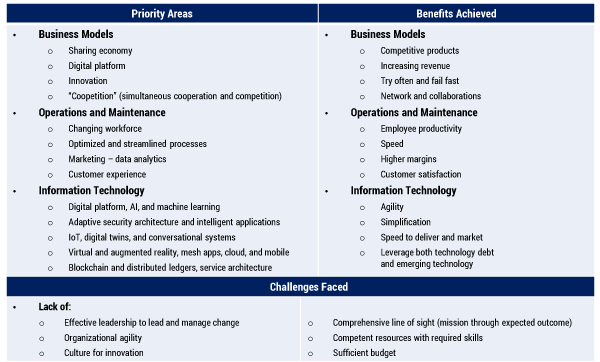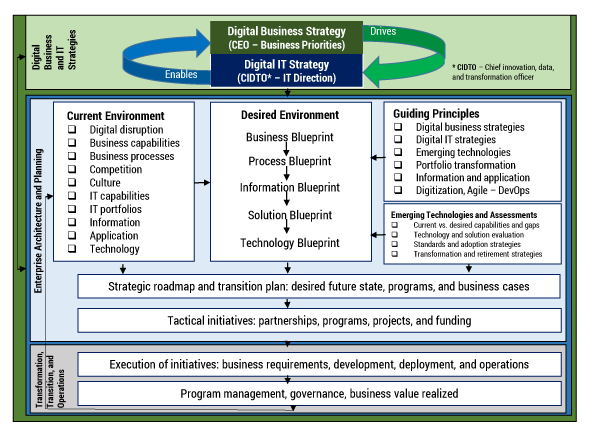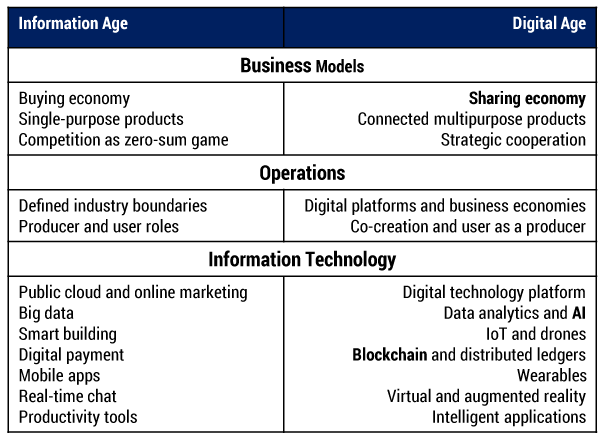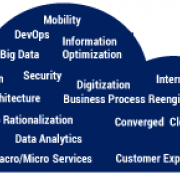CUTTER BUSINESS TECHNOLOGY JOURNAL VOL. 30, NO. 6

In this article, Seema Jain and Vipin Jain tell us how organizations can leverage EA for digital business and IT transformation. A common theme in this issue’s articles is the feeling that we are facing a big change. Jain and Jain label this change a “revolution.”
Software is eating the world.
— Marc Andreessen, cofounder of Andreessen Horowitz
The word “revolution” represents abrupt and radical changes. History shows us that whenever disruptive technologies and new ways of doing things trigger profound changes in economic systems and social structures, revolutions take place. The first one occurred millennia ago with the advent of farming and the domestication of animals. Since then, the introduction of gunpowder, the steam engine, electricity, the airplane, the telephone, the Internet, and others have represented further revolutions of varying intensity. Today we are at the dawn of another big revolution: the “digital revolution,” characterized by the sharing economy, digital platforms, ubiquitous Internet, customer experience, mobility, cloud, Internet of Things (IoT), data analytics, machine learning, artificial intelligence (AI), robotics and automation, and more.
No industry is immune to the digital revolution, and most of them are in varying stages of understanding and responding to the phenomenon in the hope of retaining — and hopefully growing — their market share and becoming digital businesses. The vast majority of companies are already investing in digital transformation projects or are planning to do so.
Figure 1 provides a high-level overview of priority areas being addressed by digital business and IT transformation and some of the benefits achieved by companies as they become digital businesses. Overall they’re increasing revenue, improving customer loyalty, boosting efficiencies, reducing costs, and transforming business models and processes. To maximize the potential of a digital business and IT transformation, however, businesses must overcome barriers that include talent gaps and a lack of leadership and organizational agility. Digital technologies such as IoT and AI are being embedded into core value-generating processes in business and society, transforming people’s daily and professional lives.

Figure 1 — Digital business and IT transformation: priorities, benefits, and challenges.
Digital Business and IT Transformation Is a Journey
The last 10 years of IT have been about changing the way people work. The next 10 years of IT will be about transforming your business.
— Aaron Levie, CEO of Box
Digital business and IT transformation is a very complicated undertaking. The starting point can vary, but in general it involves adoption of disruptive technologies and emerging business models, which in turn demands changes to organizational structure and business capabilities and processes. Transformation requires delicate, timely, and successful execution and management of changes being made to all aspects of a company, including business models, operations, and underlying IT, while optimizing use of resources and delivering innovative business capabilities. Having participated in and led multiple digital business and IT transformation initiatives, we believe that having a successful, well-connected, and respected enterprise architecture (EA) group with experienced enterprise architects is critically important in an organization’s effort to become a successful digital business. EA provides an approach for understanding and managing the complexity of digital transformation. As shown in Figure 2, EA plays a central role in enabling the transformation of a current business (or a startup, or a new line of business) into a digital business, while considering and supporting overall strategic digital business and IT strategy. Now let’s review the key components of digital business and IT transformation.

Figure 2 — Digital transformation is a continuous journey, and EA plays a vital role in managing the complexity involved.
Digital Business and IT Strategies
Silicon Valley is coming, and if banks don’t up their game, then tech companies will take over the industry’s business. There are hundreds of startups with a lot of brains and money working on various alternatives to traditional banking.
— Jamie Dimon, CEO, JPMorgan Chase
Executives like Dimon are taking the risks associated with digital disruption seriously and not only confronting them directly, but taking advantage of the opportunities these disruptions present. Digital leaders continuously stay ahead of the curve in terms of new technologies and business models, invest heavily in developing optimized innovative solutions, and disrupt their own industries (or at times create brand-new ones) in order to remain industry pioneers and leaders. As seen in Figure 2, digital disruption, competition, and emerging trends are driving overall digital business strategies, which then drive digital IT strategies. Effective digital IT strategies and successful execution of long- and short-term plans enable organizations to realize the goals of digital business strategies and provide guidance to enterprise architecture. Consider some digital pioneers that have disrupted their own industry or created one that did not previously exist:
-
Netflix disrupted the overall video/game rental industry first by providing unlimited DVDs by mail and then by offering video streaming. The company has continued to disrupt the entertainment industry by becoming a producer of TV programs, with 90+ million subscribers. Within a decade of its existence, Netflix forced previous industry leader Blockbuster into bankruptcy.
-
Amazon, a pure digital company, disrupted the retail market, resulting in the closing of many electronics store chains and malls while increasing its customers’ loyalty. By leveraging its cost-effective and time-sensitive supply chain and fulfillment capabilities, Amazon continues to disrupt many other industries, such as groceries (with the acquisition of Whole Foods) and cloud services (having become the leading IaaS/PaaS/SaaS provider, with over 140+ services). Within 11 years, Amazon Web Services has become the number one cloud provider, moving way ahead of such firms as Google, Microsoft, and IBM.
-
John Deere is transforming itself from a company that sells and services big equipment to a company that helps farmers find more efficient ways to grow crops by utilizing new technologies like IoT, drones, and data-centric capabilities.
Digital disruption is becoming an essential part of the normal business cycle. To survive and thrive in this era, businesses need to fully grasp the leading new technologies; the shifting business, operational, and IT paradigms; and the implications of both for business — while proactively planning for disruptions caused by it all. Without proper planning for these disruptions, there is a high risk of becoming irrelevant in a short period, as businesses may not be able to compete successfully in dynamic markets. In today’s fast-moving environment, strategic, practical, and innovative partnerships between business and technology executives play a critical role in helping businesses respond to these forces of change.
As depicted in Figure 3, a paradigm shift is taking place across business models, supporting operations, and underlying information technologies. Leveraging any one of these by itself is quite disruptive and challenging, but when combined together, they represent a very complex undertaking with associated risks and awards. When it comes to emerging business models or technologies, we need to understand where they come from; how they will fit, benefit, and/or pose risk to the business; and where they are going. Each one of these elements could potentially have social, ethical, legal, financial, or governance implications, and these need to be addressed as well. Before we leverage new business models or technologies in the development of business solutions, we need to comprehend them holistically. Enterprise architecture and architects play a vital part in managing this complexity while delivering promised business value. Let us briefly look at three of these emerging trends and technologies.

Figure 3 — Shifting business, operations, and IT paradigms.
Sharing Economy
The sharing economy allows individuals or businesses to use a service or rent an asset (with or without value-added services owned and provided by someone else), most probably using a digital platform. Such an economy allowed companies like Uber and Lyft to become leading providers of taxicab services without procuring any vehicles. Similarly, Airbnb has become one of the leading hospitality companies, with the largest number of available rooms and properties, without acquiring any properties itself. Instead these companies have provided an efficient digital platform for consumers and providers to conduct seamless transactions.
The sharing economy model is most likely to be used when the price of a particular asset or service is high and the asset is not fully utilized all the time. One thing to fully understand and plan for is possible legal liability and/or security issues.
Artificial Intelligence
AI makes us think of self-driving cars, drones delivering our holiday packages, and computers defeating humans at board games. Perhaps we might even envision Skynet from the Terminator movies running amok. Some pundits are talking about a massive shift in our society as AI, combined with robotics and automation, threatens to replace large numbers of people in the workforce within the coming decades. Should the use of AI, robotics, and automation come with some sort of tax or a policy to provide a minimum support structure for people replaced by them? While AI offers great potential and is being pursued by many leading businesses, it poses some potential risks as well. Would-be adopters will need to consider these benefits and risks carefully and strike a balance between them.
Blockchain
Over a short period of time, blockchain has gone from being a small presence (Bitcoin) to one of the most talked about technological innovations. As Harvard Business School (HBS) Professor Marco Iansiti and Cutter Fellow and HBS Professor Karim R. Lakhani observe:
The technology at the heart of Bitcoin and other virtual currencies, blockchain is an open, distributed ledger that can record transactions between two parties efficiently and in a verifiable and permanent way. The ledger itself can also be programmed to trigger transactions automatically.... With blockchain, we can imagine a world in which contracts are embedded in digital code and stored in transparent, shared databases, where they are protected from deletion, tampering, and revision.
This could have extensive implications for the way contracts are written, financial transactions occur, and the healthcare industry operates.
Once a company has committed itself to an executable digital business and IT strategy, management must define and implement an operating model that allows for execution of that strategy. The operating model will incorporate considerations such as policies, processes, organization structures, and performance measures, with a focus on innovation, time sensitivity, and team dynamics to retain a competitive edge. Senior leadership needs to clearly articulate the strategy and the operating model to the people involved and encourage everyone to take responsibility for business success.
Enterprise Architecture and Planning
It is not the strongest of the species that survives, nor the most intelligent that survives. It is the one that is the most adaptable to change.
— Charles Darwin
Successful enterprise architects and architecture strive to align key stakeholders around a set of differentiated, optimized, and innovative business capabilities through seamless integration of people, data, process, and technology to enable businesses to achieve their vision and goals. It is an ongoing process, driven by digital business and IT strategies focused on achieving expected business value. EA provides a long-term view of an organization’s vision, strategic direction, capabilities, supporting operations, and IT portfolio so that individual projects can work toward building these capabilities instead of just fulfilling immediate needs in silos. Based on the age, nature, and maturity of your business, you may have a mixed bag of digital and legacy capabilities, or you may be just starting out (or venturing into a brand new business area) without any legacy to transform.
Irrespective of your current capabilities and portfolio size, EA is valuable for moving quickly into new and adjacent markets, pivoting rapidly to seize new opportunities for revenue generation, and bringing new business models up to speed before your competitors can react. Efficient EA should provide a comprehensive understanding of current and desired capabilities, services, solutions, systems, information, applications, and all other components of your IT portfolio, aligned with the constantly evolving needs of the business. When the business needs change, your EA should enable you to adapt and respond in short order.
Guiding Principles
Enterprise architecture guiding principles are high-level fundamental tenets that direct business and technology leaders and enterprise architects in the decision-making process. Even though such principles will be specific to each organization based on its needs, the following should be applicable to most:
-
EA is a business-driven process. A technology-first approach that doesn’t align to digital business and IT transformation efforts will fail to deliver the anticipated return.
-
EA must link strategy, business, people, process, technology, and operations. It is most effective when it simultaneously supports top-down executive planning and decision making across the enterprise and bottom-up management planning and decision making within each line of business.
-
The approach to enterprise architecture must be flexible and customizable to address business requirements and respond effectively to digital disruption, including emerging technologies and business models. It should focus on agility, innovation, business value, and efficiencies.
-
EA should serve as a compass, directing an enterprise toward its intended operating model and ensuring each initiative achieves both local and enterprise-wide objectives.
-
Enterprise architects should make an early decision on what framework and tool, if any, they will use and which primary EA artifacts will be developed by whom, when, and for what purposes.
-
Enterprise architects should concentrate on both short- and long-term benefits, to continually demonstrate the business value of EA while retaining and growing senior leadership support.
-
It is critical for enterprise architects to collaborate and work closely with other organizations as they guide the development, sharing, and integration of a single view of the business and technology landscape — in other words, the enterprise architecture.
EA Benefits
A successful EA implementation should yield a number of benefits around decision making, resource optimization, and the ability to respond quickly to disruptive trends and technologies. Even though the exact benefits achieved will be unique to each organization, the following should be applicable to most:
-
Increased speed and ability to translate the organization’s strategy into the necessary initiatives and investments
-
Efficient portfolio-driven strategic decision making — the ability to analyze increasingly large and complex environments, assess the impact of disruption, and develop a strategic plan to address it
-
The ability to manage and maintain relevant artifacts in one repository
-
An integrated digital business model, including business model, operational model, and supporting IT
-
Efficient resource management — cost, facilities, infrastructure, applications, and people
-
Improved usage of shared services — cloud-based solutions and elimination of silos
-
Agility — improved responsiveness to business requirements and digital disruption
-
Improved risk management — reduced business risk, increased disaster recovery/business continuity planning capacity
EA Objectives
An organization’s approach to developing various EA artifacts will be influenced by the selected EA frameworks and tools, if any. Regardless of the chosen framework or tool, the basic intent of enterprise architecture remains the same and focuses on the following:
-
Comprehending the overall strategic direction and guiding principles so as to make strategic decisions
-
Understanding the current environment, including the competition, capabilities, and IT portfolio
-
Evaluating disruptive technologies, business models, and solutions
-
Establishing standards and developing adoption, transformation, and retirement strategies
-
Defining the desired environment and blueprints to address today’s business requirements while anticipating future ones
-
Identifying gaps and the key initiatives required to fill them; understanding dependencies between initiatives and the organization’s capacity to move forward (and the limitations to that capacity)
-
Developing technology roadmaps and transition plans to achieve the stated business vision
-
Collaborating, communicating, and demonstrating the ongoing value of enterprise architecture in order to sustain key stakeholders’ buy-in
EA represents change, and most people resist change until they clearly see the value of it for themselves. It is vital to communicate the value of EA through tangible results, whether these are quick wins or the realization of long-term strategic goals.
Targeting EA to Digital Business and IT Transformation
Even though all of the elements described above are important aspects of traditional EA, given the pace of digital disruption and the need to move fast in response to competition, businesses may want to think carefully about which parts of EA are most important for them and how much effort they should focus on those. Each transformation initiative is unique, and so should be the transformation approach and the EA group’s focus. Consider the following examples in which various organizations used a personalized version of an overall transformation and EA approach to meet their specific requirements:
-
In Company A, the leadership decided to expend a bare minimum of effort to understand their current environment (IT portfolio, operations, etc.), focusing instead on their desired environment and evaluating emerging cloud-based solutions to reduce time to deliver on required capabilities. Their strategic direction was to move out of the business of IT and concentrate on their core business capabilities, which resulted in a shift from a CAPEX to an OPEX model.
-
In Company B, the leadership decided to focus on bringing in new capabilities through the optimization of their current business processes, simplifying their IT portfolio while transforming it to the selected platform. This required a heavy emphasis on business process reengineering and modeling as they sought to leverage the portfolio’s full capabilities with minimum custom code.
-
In Company C, the leadership decided to leverage DoDAF as a framework. But although the framework suggested 63 types of views, the company chose to develop only 15. This allowed them to concentrate on the views that were critical for them and make optimal use of resources.
EA can be an effective tool for addressing digital and IT transformation in businesses of any size, as long as they are not rigid about their approach and do not try using a big hammer where thumb pressure will work. It is important for enterprise architects to tailor their EA approach to what is feasible in the organization. Enterprise architecture sounds like a technical discipline, but it is primarily focused on business, and management of it should be the joint responsibility of the business, operations, and technology groups.
Think of EA as a framework for enabling all the disparate parts of the enterprise to function together as one seamless engine of productivity. EA allows for the ongoing synchronized alignment of business, operations, and IT. Without this alignment, businesses are exposed to risks, and bringing new products and services to market to meet the shifting demands of their customers becomes difficult.
Transformation, Transition, and Operations
One IT executive in an investment banking company claimed that 80% of his company’s programming code was dedicated to linking disparate systems, as opposed to creating new capabilities. The significant problems we face cannot be solved by the same level of thinking that created them.
— Jeanne W. Ross, Enterprise Architecture As Strategy: Creating a Foundation for Business Execution
Figure 4 provides a high-level overview of the primary characteristics of many current businesses, the desired capabilities of a digital business, and the kinds of technologies and initiatives that may be required to get from one to the other. Through its various blueprints of the desired environment, strategic roadmaps, and transition plans, EA provides a vision and a high-level plan to start the process of transformation. Although digital transformation may require the introduction of some new technologies, business models, or processes, this is neither a requirement nor does it guarantee the transformation of your current business into a digital business. What is required for efficient transformation is an effective holistic plan for optimizing the overall portfolio within the scope. How should business processes be redesigned to support required capabilities, and who should decide on what gets retired, retained, re-architected, replaced, and/or developed? It requires an active collaboration between enterprise architects, solution architects, and individual project teams who are leading the individual initiatives as they move forward with detailed architecture, transformation, and deployment activities.

Figure 4 — Characteristics of current and digital businesses and enabling technologies.
The transformation of a portfolio is a continuous and longer process, with a focus on getting to a stage where the current portfolio is serving business needs well and is proactively being modernized to respond to future needs. EA is an enabler of this process, providing ongoing support as other teams take a bigger role after initial planning and architecture.
Designing for Digital Disruption
At least 40% of all businesses will die in the next 10 years … if they don’t figure out how to change their entire company to accommodate new technologies.
— John Chambers, Executive Chairman, Cisco Systems
There is no one right digital business design, but given that digital businesses are more integrated and automated than traditional businesses, they must be more explicitly designed. Digital businesses are heavily dependent on software to facilitate seamless end-to-end experiences; store, process, and analyze data; and bring new products and services to market. As a result, companies need to be designed with the same kind of detailed attention to component interaction that is applied in complex systems design.
The design of a digital organization starts with a digital business, operations, and IT strategy. Because digital technologies offer a constant stream of new opportunities, the best digital strategies provide a clear direction while remaining responsive to shifting circumstances and prospects. As a result, digital strategies tend to be more visionary than traditional business strategies.
The practice of enterprise architecture creates one enterprise view of the operating model — synchronizing stakeholders and creating an organizational blueprint that charts the future of the business and drives strategic decision making around investments and priorities. EA approaches need to adapt for a digital economy and bridge the gap between business strategy and execution.
In closing, we’d like to leave you with an observation by Amazon founder and CEO Jeff Bezos:
In today’s era of volatility, there is no other way but to reinvent. The only sustainable advantage you can have over others is agility, that’s it. Because nothing else is sustainable, everything else you create, somebody else will replicate.
As digital disruption accelerates, having an effective EA group is now more valuable to organizations than ever before. Digital transformation is essential, and the enterprise architect plays a critical role in its success.




